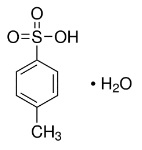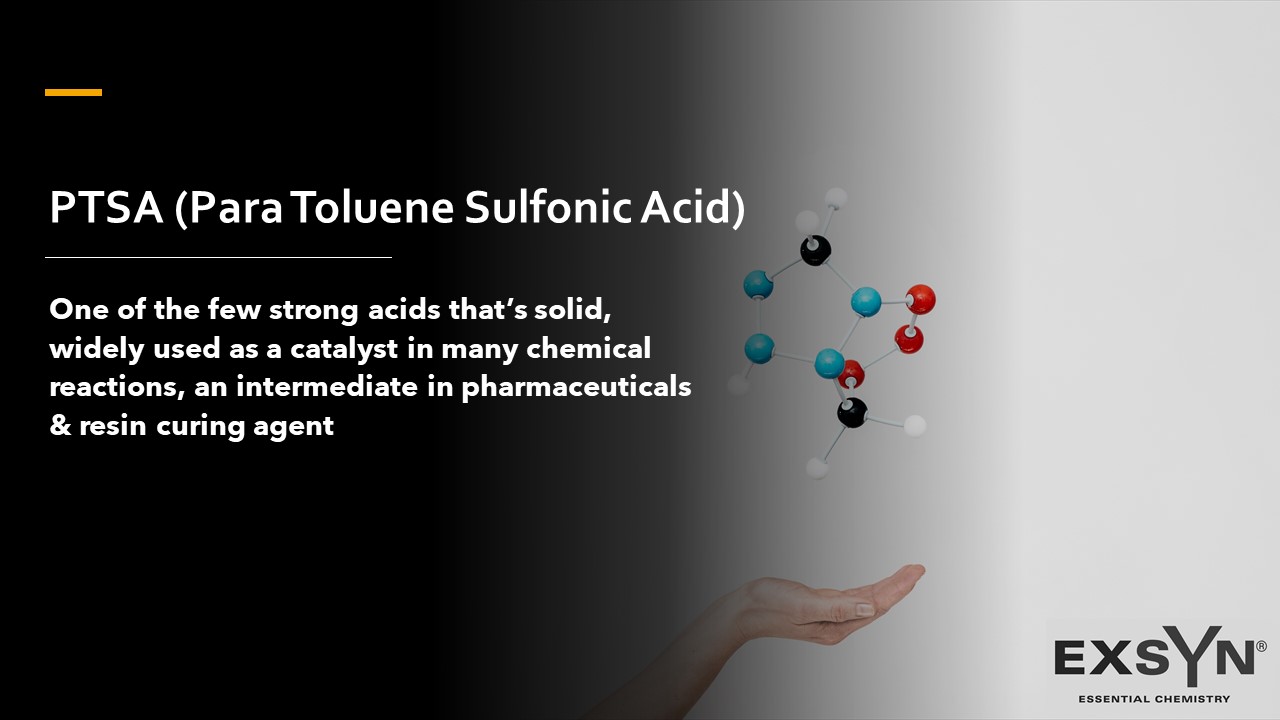INTRODUCTION
PTSA or pTsOH or Tosylic acid (TsOH) is white solid organic compound, that is soluble in water, alcohols, and other polar organic solvents. The group is known as the tosyl group and is often abbreviated as Ts or Tos.
TsOH is about one million times stronger than benzoic acid. It is one of the few strong acids that is solid and hence conveniently weighed. It is available both in crystalline form as well as a solution and has a wide range of applications.
| Synonyms | 4-Methylbenzenesulfonic acid Tosic acid, Tosylic acid PTSA |
| CAS no. | 6192-52-5 (monohydrate) 104-15-4 (hydrous / solution) |
| EINECS no. | 203-180-0 |
| Molecular formula | C7H8SO3.H2O |
| Molecular weight | 190.22 |
| Structure |  |
APPLICATIONS
PTSA is widely used as a catalyst and as an intermediate in a variety of applications such as:
| A catalyst in the synthesis of pharmaceuticals, pesticides, polymerization stabilizer, paint intermediates, cross linking reactions and resin curing agent. It is also a commonly used acid catalyst in organic synthesis. |
| As an intermediate in fine chemicals, dyestuffs & pigments. |
| As a curing agent in thermosetting resin systems, varnishes, acrylic resins, etc. |
| As a hydrotropic coupling agent & a wetting agent in esterification / condensation / acetylation / polymerization / alkylation / hydrolysis / dehydration. |
| It is comparable in strength to mineral acids such as sulphuric acid but is especially suitable for organic reactions where an inorganic, mineral acid could cause charring, oxidation or an unwanted chemical reaction. |
SPECIFICATIONS
| Test | Unit | Specification |
|---|---|---|
| Appearance* | – | White crystalline powder |
| Assay on Monohydrate basis | % | Min 98 |
| P-isomer content in the active Material by a) HPLC method b) Others | % – | Min 92 Balance |
| Free Sulphuric Acid | % | Max 0.3 |
| Iron Content | ppm | Max 10.0 |
| Total Moisture | % | Max 11.50 |
| Melting Point | °C | Min 99 |
| Solubility in water | – | 100% soluble, clear solution |
*Note: The international specification of PTSA is white to off white to pink, though the material supplied would be white. However, as the product is highly hygroscopic – due to heat, sunlight and moisture the color may change from white to off white or pinkish in the course of time.
SPECIFICATIONS of 65% solution
| Test | Unit | Specification |
|---|---|---|
| Appearance | – | Pale yellow to amber colored liquid |
| Assay (on Anhydrous basis) | % | Min 65.0 |
| Free Sulphuric acid | % | Max 1.0 |
| Specific gravity (at 25°C) | – | 1.22 ± 0.02 |
REACH status
PTSA offered by ExSyn is registered under EU REACH regulation.
STORAGE
The product is stored at ambient temperature.
ExSyn can offer PTSA grades as low as 0.1% free sulfuric acid, resulting in lower corrosion of user’s equipment and can also offer customized specifications if needed.
No matter the quantity you need, our exceptional quality and service will make ExSyn your supplier of choice! If you need any additional information or SDS, please get in touch with us.
Iodine is anon-metallic, dark-grey/purple-black, lustrous, solid element. It is the heaviest and the rarest of stable halogens that can be found on the crust of earth.About fifty percent of all iodine produced and manufactured worldwide is used to form Organoiodine compounds. Iodine is an important element for many health-sustaining processes and essential for human thyroid health.
The product, acronymed Oct-NBE, is an organic compound with a cyclic ring system and a 8-membered hydrophobic chain. The structure renders the chemical special properties leading to its applications in diverse fields.
Nicotine is a hygroscopic, colorless to slight yellow, oily liquid, that is readily soluble in alcohol, ether or light petroleum. It is widely used recreationally as a stimulant and anxiolytic.
The product, acronymed ETD, is an organic compound with a fused bicyclic ring system and an ethylidene group. The structure renders the chemical special properties leading to its applications in diverse fields.
Sodium perchlorate monohydrate is the inorganic compound with the chemical formula NaClO4•H2O. It is the common existence form of sodium perchlorate, which can gradually absorb water in the air to form the monohydrate. Sodium perchlorate monohydrate is white rhombic crystal which is highly soluble in water and in alcohol. Its capacity to undergo redox reactions, liberating oxygen atoms, has been harnessed in the preparation of specialty chemicals, including pharmaceutical intermediates and fine chemicals.
Triphenylphosphine is a common organophosphorus compound that is frequently abbreviated as PPh3 or Ph3P. It is widely used in organic and organometallic compound synthesis because it is an effective reducing agent as well as a neutral ligand. At room temperature, PPh3 crystals are relatively air-stable and colourless.
Potassium chlorate holds significant importance across various industries due to its diverse applications. This white crystalline compound has been utilized for centuries as an essential ingredient in the production of matches, fireworks, and explosives, owing to its ability to release oxygen upon decomposition.
Podophyllotoxin is a non-alkaloid toxin lignan extracted from the roots and rhizomes of Podophyllum species. It is an organic heterotetracyclic compound that has a Furonaphthodioxole skeleton bearing a 3,4,5-trimethoxyphenyl substituent.
Octadecylphosphonic acid (ODPA), a versatile chemical compound, serves as a surfactant and dispersant in applications spanning coatings, lubricants, and corrosion inhibition. With its hydrophobic octadecyl chain linked to a phosphonic acid group, it excels in surface modification, boosting adhesion in metal surfaces.
